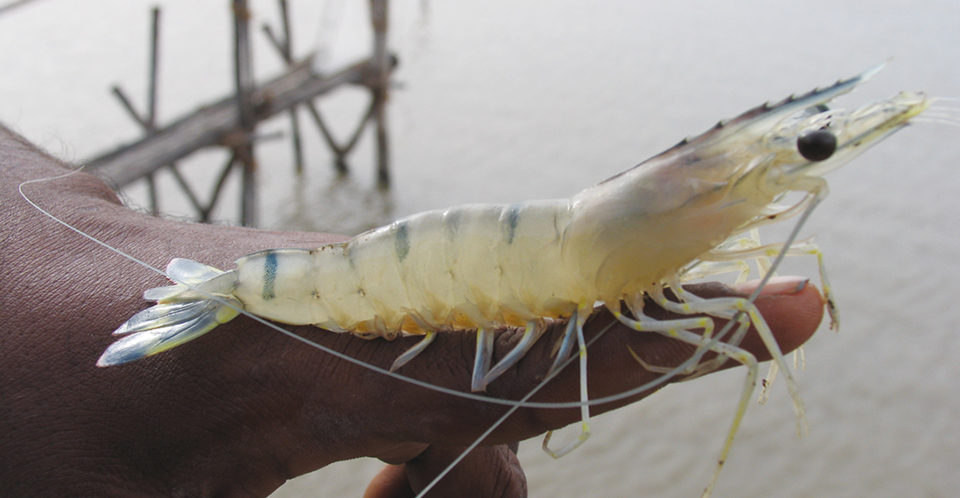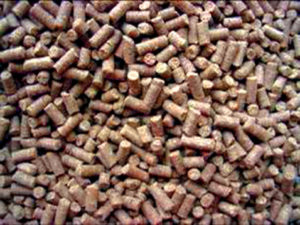Paradigm is changing for dietary inclusion levels in shrimp feeds

Knowledge of essential amino acid (EAA) requirements in penaeid shrimp is critical for least-cost optimization of commercial feed formulas. Without this information, as well as that for nutrient digestibility coefficients, the cost efficiency of feed ingredients can only be estimated, and proper nutrient delivery is difficult.
Unlike formulating for traditional agricultural feeds, shrimp feed formulations are not typically based on EAA availability or EAA ratios. Quite often they are only formulated to crude protein levels.
Interest in plant proteins
There is a general tendency for feed formulators to accept currently used dietary inclusion levels for EAA in shrimp production feeds, but this paradigm is changing with increased interest in the development of plant protein-based feeds that use less fishmeal.
Plant proteins are often avoided in aquaculture feeds due to low EAA content and the need to address limiting nutrients. For example, soybean meal has relatively high levels of digestible protein and is replete with lysine, but has low levels of methionine. Hence, soybean meal is typically not used as the sole source of protein or EAA in shrimp feeds.
Cost optimization of commercial plant protein-based shrimp feeds is often perceived as constrained due to a lack of information on the requirements for total sulfur-containing amino acids (TSAAs, methionine plus cystine). Most commercial formulations using moderate levels of protein do not include minimum restrictions for methionine and/or TSAA in the formulation matrix.
Recommended levels
Many years ago, Japanese researchers estimated that the optimal dietary concentration of EAA for shrimp should resemble that of the whole-body EAA composition. This correlation is still somewhat accepted today, despite the tendencies of shrimp tissue to vary substantially in EAA content due to age, species, tissue type, and test methodology. In addition, these estimates do not consider the variation in and digestibility of protein sources. For example, reported concentrations of TSAA as percentage of protein have varied 2.39 to 3.51 percent for black tiger shrimp (Penaeus monodon).
By another approach, if one uses a ratio of methionine in tail muscle tissue of Penaeus monodon to its determined requirement for arginine, an estimated TSAA requirement of 2.67 percent of dietary protein results. This is somewhat lower than the 3.00 percent feed level commonly found in commercial formulas.
In the only study to actually determine TSAA requirements for marine penaeid shrimp, a TSAA requirement of 3.50 percent of dietary protein was reported. It should be noted, though, that the growth trial was conducted with 21-mg shrimp that achieved a final weight of 209 mg. The requirement level was basically determined for nursery-phase shrimp and involved numerous nutrient delivery problems.
Estimated and determined TSAA requirement levels for marine penaeid shrimp are summarized in Table 1. This table gives the impression that apparent requirements for methionine and TSAA by marine penaeid shrimp are not only higher than commonly used feed levels, but also quite variable within species. In most cases, methionine and TSAA requirements have only been estimated or calculated using shrimp tail muscle or whole body amino acid profiles. Given the lack of information on TSAAs and their importance to feed formulation, it is critical that this requirement be carefully determined.
Fox, Recommended, calculated, or determined methionine, Table 1
| Reference | Species | Methionine (% of Protein) | TSAA (% of Protein) |
|---|
Reference | Species | Methionine (% of Protein) | TSAA (% of Protein) |
|---|---|---|---|
| Deshimaru (1981)* | M. japonicus | 2.9 | 3.1 |
| Akiyama et al. (1989)* | Penaeid shrimp | 2.4 | 3.6 |
| Liou and Yang (1994)* | P. monodon | – | 4.0 |
| Chen (1998)* | P. monodon | 2.0 | 2.7 |
| Millamena et al. (1996) | P. monodon | 2.4 | 3.5 |
| Teshima et al. (2002)** | M. japonicus | 1.3 | 2.6 |
| Auburn-TAMUCC | L. vannamei | <1.3 | < 2.7 |
Recent studies
The authors recently conducted studies at Texas A&M University – Corpus Christi and Auburn University in the United States to evaluate methionine and TSAA concentrations in practical, plant protein-based feeds offered to juvenile Pacific white shrimp (Litopenaeus vannamei).
The studies comprehensively addressed research issues associated with soybean replacement of fishmeal, including identification of a water-stable source of methionine, determination of in vivo methionine digestibility from various synthetic sources, and evaluation of growth of shrimp fed diets containing graded levels of synthetic water-stable methionine.
TSAA requirements
To ascertain dietary requirements for TSAA, an initial feeding trial utilized soybean meal at 25.5 percent and poultry byproduct meal at 25.0 percent in a basal diet designed to contain 35.0 percent crude protein and 8.0 percent lipid. The basal diet had a TSAA concentration of 2.8 percent of the protein.
The TSAA concentration of the experimental diets was varied using D,L-methionine to produce TSAA levels of 2.8 to 3.6 percent of protein. The mean initial weight of shrimp used in the study was about 0.24 grams. After five weeks, the shrimp showed weight gains in excess of 1,000 percent. However, there were no significant differences in weight gain among the treatments.
Leaching
Due to concerns regarding the availability of D,L-methionine, a leaching study using alternative chelated forms of methionine and a methionine polymer was then conducted. The leaching trial was undertaken with digestibility-type feeds (see below) containing D,L-methionine, polymerized methionine, and various mineral chelates of methionine analog (calcium, copper, magnesium, manganese, and zinc). Feeds were submerged and shaken at 60 rpm under salinity treatments of 0, 15, and 30 ppt. After 45 minutes, flasks were removed from the shaker and subsamples of leachate were analyzed for free methionine concentration.
Results showed significantly greater leaching at 0 ppt for all feeds and from the D,L-methionine-supplemented feed, regardless of salinity. A significant interaction in terms of leaching between salinity and diet was also shown.
These results indicated that any of the methionine supplements, with the exception of D,L-methionine, could be used for subsequent growth trials. In a published study with P. monodon, a methionine-enriched soybean plastein was shown to improve growth over that of a methionine-deficient diet. However, subsequent research with a polyamino heteropolymer showed no reduction in leaching over that of crystalline amino acids.
Methionine digestibility

The next study involved determination of methionine digestibility by shrimp. For this trial, basal and experimental diets were formulated to contain 35 percent crude protein, 6 percent lipid, with a digestible energy:protein ratio of 8.8 kcal/gram. No methionine was added to the basal diet, and methionine supplementation in the experimental diets ranged 0.12-0.20 percent. Four replicate tanks were used for each of six dietary treatments and evenly distributed within a recirculating system.
Experimentation followed a standard protocol used by the Texas Agricultural Experiment Station Shrimp Mariculture Project in Port Aransas, Texas, USA. Apparent digestibility coefficients for the test and reference diets were calculated by the indirect method and differences in apparent digestibilities.
Results from the digestibility trials showed that protein digestibility was similar for all diets. The apparent digestibility of methionine in the D,L-methionine was significantly greater than in the other dietary treatments, with the exception of the calcium diet. The digestibility values for D,L-methionine and calcium-methionine were equal or greater than that for the basal feed, which was also shared by copper-methionine, manganese-methionine, zinc-methionine, and polymerized methionine.
These results indicated that because of similarity in methionine digestibility, any of the methionine supplements, with the exception of D,L-methionine, could be used to supplement methionine requirement diets. The high apparent digestibility of the D,L-methionine feed was probably due to its leaching from either feed or feces.
A second preliminary growth trial was conducted using a simple practical diet containing 53.2 percent soybean meal, 6.0 percent poultry meal, 4.0 percent menhaden fish oil, 31.5 percent wheat starch, 2.6 percent vitamin/mineral premix, and 0.2 percent cholesterol. The basal diet was formulated to contain 32.0 percent protein, 6.0 percent lipid, and a TSAA content of 2.9 percent of protein (1.3 percent from methionine). These diets were then supplemented with synthetic methionine to bring the TSAA content to 3.0 percent of the protein.
Juvenile shrimp with 0.24 grams initial weight reared over a seven-week period showed 85 to 95 percent survival with the methionine polymer yielding lowest survival. Although weight gain was in excess of 1,500 percent, there were again no statistical differences in performance among treatments, indicating any of the forms were suitable for further research.
Final growth trial
Based on results from the previous trials, a final growth trial was conducted. Several experimental diets were formulated to contain 32 percent crude protein, 6 percent lipid, and digestible energy of 8.4 kcal/gram protein. The sources of methionine and TSAA content ( percent protein) of the diets were basal (2.62 percent); D,L-methionine 0.05 (2.77 percent); D,L-methionine 0.10 (2.93 percent); and copper-methionine (2.71, 2.81, 2.91, and 3.01 percent). No significant differences in survival (86.7-96.7 percent), percent weight gain, biomass gain, or feed conversion were shown.
These results indicated that the lowest dietary inclusion level of methionine was adequate to support a weight gain of over 760 percent in juvenile L. vannamei. The similarities in growth and feed performance were likely the result of all treatment diets possessing adequate amounts of available methionine or TSAA. This implied that an inclusion level of methionine or TSAA in commercial production feeds containing 32 percent protein could be as low as 0.4 percent of diet (1.26 percent of protein) or 0.84 percent (2.62 percent of protein), respectively. Future research will focus on reducing the methionine content of the basal diet in order to further define this requirement.
Editor’s Note: Cited references are available from the first author.
(Editor’s Note: This article was originally published in the March/April 2007 print edition of the Global Aquaculture Advocate.)
Now that you've finished reading the article ...
… we hope you’ll consider supporting our mission to document the evolution of the global aquaculture industry and share our vast network of contributors’ expansive knowledge every week.
By becoming a Global Seafood Alliance member, you’re ensuring that all of the pre-competitive work we do through member benefits, resources and events can continue. Individual membership costs just $50 a year. GSA individual and corporate members receive complimentary access to a series of GOAL virtual events beginning in April. Join now.
Not a GSA member? Join us.
Authors
-
Joe M. Fox, Ph.D.
Harte Research Institute
Texas A & M University
6300 Ocean Drive
Corpus Christi, Texas 78412 USA -
D. Allen Davis, Ph.D.
Department of Fisheries and Allied Aquacultures
Auburn University
Auburn, Alabama, USA -
Addison L. Lawrence, Ph.D.
Texas Agricultural Experiment Station
Shrimp Mariculture Project
Texas A & M University System
Port Aransas, Texas, USA
Tagged With
Related Posts

Health & Welfare
Effect of dietary methionine on Pacific white shrimp juveniles
This study tested five diets formulated with increasing levels of methionine (Met) and Met + cysteine (Cys) and their effect on growth performance of juvenile Pacific white shrimp stocked at 50, 75 or 100 animals/m2 in a green water system.

Aquafeeds
A look at corn distillers dried grains with solubles
Corn distillers dried grains with solubles are an economical source of energy, protein and digestible phosphorus to reduce feed costs and fishmeal usage.

Health & Welfare
Amino acid supplementation reduces protein levels in pangasius diets
Trials show that supplementation with amino acids could reduce protein levels from a typical 28 percent to 23 percent in pangasius diets.

Aquafeeds
Animal byproduct concentrates useful tools in formulation
With the market volatility of fishmeal, as well as rising sustainability concerns, the aquaculture industry is seeking sources of protein, such as animal byproduct concentrates, to substitute for fishmeal.


